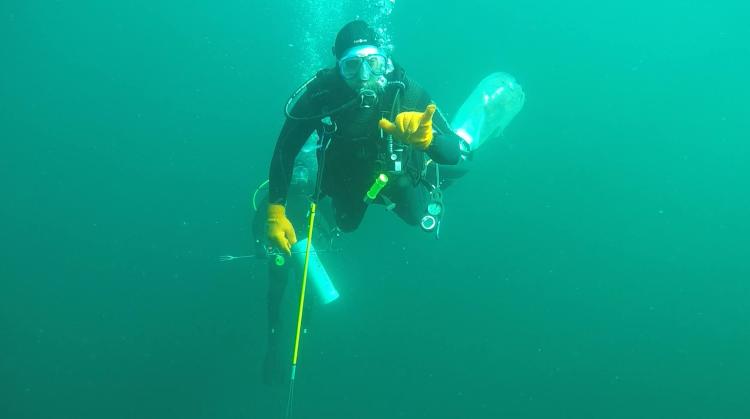
Ken Ayers Jr. (MTeleComm’87) is doing more than his fair share to fight back against Florida's invasive lionsfish problem.
Florida has a lionfish problem.
The invasive sea creature, though remarkable to look at, is destroying marine ecosystems by eating everything in sight.
Ken Ayers Jr. (MTeleComm’87) is doing more than his fair share to fight back. He was named the state’s 2017 Lionfish King after removing 1,250 invasive lionfish off the coast in a statewide competition. And he’s still at it.
“The only way right now to successfully hunt lionfish is with a pole spear while diving,” said Ayers, an Air Force veteran and master dive instructor with more than 1,700 dives under his belt.
Last year, Ayers and fellow participants removed 26,321 lionfish during the four-month competition, sponsored by the Florida Fish and Wildlife Conservation Commission. This year’s Lionfish Challenge started May 19 with the fourth annual Lionfish Removal and Awareness Day and runs until Sept. 3.
 This time, Ayers is shooting to catch 1,500 lionfish.
This time, Ayers is shooting to catch 1,500 lionfish.
An aquarium staple, the lionfish is famous for its colorful vertical stripes, 18 venomous spines and feathery fins. It’s native to the South Pacific and Indian Oceans and is part of the scorpionfish family.
The exact cause of Florida’s lionfish invasion is unknown, but many experts speculate the species was introduced to local waters in the 1980s, when citizens began releasing unwanted aquarium fish into the Atlantic Ocean. More are said to have escaped from damaged tanks when Hurricane Andrew swept across the Bahamas and Florida in 1992.
Once introduced, the fecund fish spread through the marine ecosystem like wildfire. According to the National Oceanic and Atmospheric Administration, a single female lionfish can spawn more than two million eggs a year.
This is where Ayers comes in.
After retiring from the Air Force in 1995, he moved to Hawaii, where he learned to scuba dive. When he moved back to Florida in 2013, he started to spearfish.
“I was looking for a way to help our environment and dive too. Spearfishing became a perfect fit.”
That year, Ayers shot 95 lionfish off the coast of Panama City in Florida, where he lives.
“After that, I was hooked,” he said.
On one of Ayers’ first lionfish hunts, he got distracted by all the colorful fish and lost track of how much oxygen was in his tank.
“Before I knew it, I was down to less than 100 [cubic feet] in my tank,” he said. “You should end your dive at 500 so you can make a safe ascent and do a safety stop.”
If a diver collects too many fish in one dive, they can be buoyed to the surface by the dead fishes’ expanding swim bladders. Ken learned this the hard way, after collecting 55 lionfish and finding himself rocketed upwards.
Invasive lionfish are found along the southeast coast of the U.S., the Caribbean and in parts of the Gulf of Mexico. They infest coral reefs and feed on more than 50 species of fish and crustaceans.
Since lionfish have no natural predators in Atlantic waters and reproduce abundantly, they can upend the food chain by eliminating native plants and animals and monopolizing limited resources.
The lionfish boom has serious implications for marine ecosystems, and the problem is unlikely to go away soon, if ever — despite Ayers’ efforts.
Still, one way to fight back, he says, is to fry up the fish for dinner.
Seafoodwatch.org, a website for environment-conscious fish eaters, lists lionfish as a “Best Choice” option: “When you buy lionfish, you’re helping to prevent the spread of this invasive species in U.S. waters.”
Ayers’ favorite way to eat lionfish is pan-fried and smothered in butter.
His cats prefer it sashimi-style.
Top photo by @iStock/abadonian; Photo courtesy of Ken Ayers Jr.





